by Zachary Clemente

In the incredibly crowded Artist Alley of New York Comic-Con, I sat down with illustrator Wes Craig to talk about his work on Blackhand Comics and Deadly Class, both published in print by Image Comics. His work exhibits some of the most exciting paneling structures and dynamic representation of motion, at least to me. I’m pleased to say that our conversation was halted many times as eager attendees came up get copies of Deadly Class signed, buy a copy of Blackhand, or just share a few words. Craig was worked on Guardians of the Galaxy, Judge Dredd, T.H.U.N.D.E.R. Agents, Batman Annual, and many more.
Comics Beat: Like many, I first found your work in Deadly Class, then started look at Blackhand [Comics]. I found your panel structure and your ability to move the reader’s eye dynamic and fluid, even when panels doesn’t necessarily exist. How does your process begin and how does that looser form start taking place?
Wes Craig: For years in my sketchbook, I’ve been trying to think of different ways of presenting a page as something you maybe haven’t seen before. Deadly Class was kind of my first opportunity to do that for other people to see. I did a bit of it in Blackhand and my previous work for myself that no one really ever saw, but Deadly Class was the first public version of that.
I take what Rick [Remender] has in the script and I try to figure out what the scene is about. A lot of have people have brought up the first issue – it’s really just a flat-out chase scene. I know that you can’t present motion in comics and that’s a problem with comics: you can’t do music or motion – but I try to make the page dynamic and make it feel like it’s kind of moving. So, I go back to my sketchbooks to come up with as many ideas as I can like breaking the borders or having characters fall into the next panel, and all that kind of stuff helps with that feeling.
CB: With Blackhand, I didn’t realize how it was going to be published in print. It being an object with a horizontal format is exciting.
WC: Those started off as webcomics and I wasn’t sure at first if I was ever going to publish them – that’s why it’s kind of formatted like a computer screen. It makes for an interesting looking thing and not may books have those dimensions. It stands out in a stack of other comics.
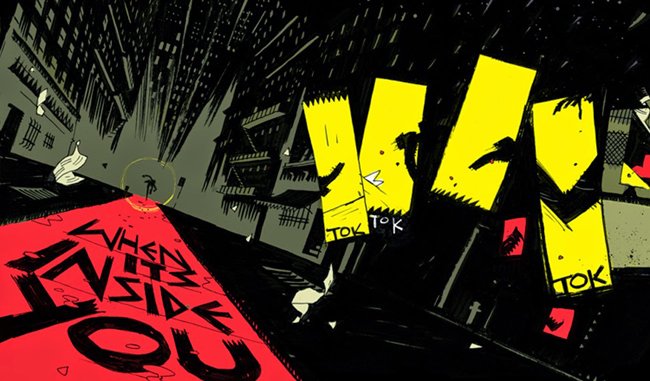
CB: The three stories in Blackhand all exhibit very different paneling styles each a discussion on three different types of stories. When did you working on Blackhand?
WC: It started around the same time as Deadly Class, I forget exactly. I think I started it just before Rick initially emailed me to work on Deadly Class, so it’s been going on for a while. It just takes a while to get it done, obviously. I do it in between issues; there’s usually a little gap between when I finish an issue of Deadly Class and when the next script comes in. I’ll try to get in as many pages as a I can, sometimes on weekends or whatever. Most of my days are spent on Deadly Class so it’s kind of a slow process, but I still managed to release three stories in this book. I have two new stories online, and I’m working on the thumbnails of the third story. That’ll all hopefully be Blackhand Book 2, maybe next year or something.
CB: Will that be through Image as well?
WC: Yeah, I think this’ll [Blackhand Comics] do well enough that it’ll be good for everyone involved – they seem to be totally up for it.
CB: It does appear to be flying off your table.
WC: I actually had to go back to the Image booth to get more from them. They have so many books there, that this can get lost in the shuffle for them but for people specifically coming to see me, it’s right there. [Gestures to the sole remaining copy on his table]
CB: I couldn’t find a lot about your earlier career, what was the path you took?
WC: I’ve been working professionally for a little bit over 10 years–I keep saying that, but I’ve been saying it for two years now. So 12 years or whatever it may be, but it’s always been an issue of this here, an issue of that there. [I had] a little run on some Wildstorm stuff back in the day, a little run of Guardians of the Galaxy – so I’ve never been known as the guy who does that one thing. This convention’s a very different experience for me now because I’m the guy drawing Deadly Class so I have a constant stream of people that are into it here to see me.
The initial thing with Rick started when I did an issue with Lee [Loughridge] [for DC] – I’m a big fan of his work in Deadly Class and his work in general. I kept on bugging DC with working with with Lee, thinking we’d match up well together; it took a while to convince them, but when we finally got the chance with the Legends of the Dark Knight digital comic. […] I think Rick used to live down the street from Lee and they’d get together, drink beers, and shoot the shit and when Lee was working on one of the Batman pages, Rick leaned over asking “who’s this guy?” It was pure coincidence – I’m a big Rick Remender fan and I’m a big fan of the artists he chooses to work with; I was flattered that he gave me the shot. We get along well now and it’s kind of the perfect situation.
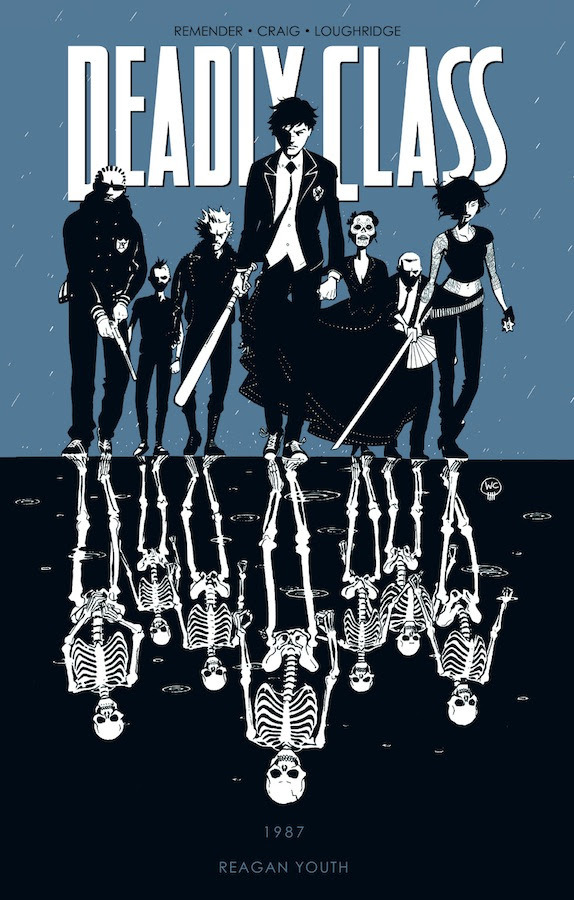
CB: It looks like you never really had any ownership in your previously published work. How is it having way more of an input within a full story?
WC: It’s great, man. You just feel more invested in it – all that experimental page composition stuff was always in the back of my mind, but I never tried it in the Marvel or DC stuff. People seem to love it and I wonder why I didn’t start doing it earlier, but you just don’t feel the same way. […] You’re not sure you want to give them your best stuff because once you give them that, they own it. You don’t see as many characters being created for those companies anymore. If they have a great character, they’re going to do it themselves. Once I started Deadly Class, I felt more free to stretch out.
CB: What kind of input do you have on how the story of Deadly Class forms?
WC: That’s part of–not just being co-owners–but being invested. […] He’ll do the plot, but we’ll talk out ideas a lot, informing what will become the next issues and we’ll talk out where we want to go with it. I feel like the other books that he’s working on are more structured in terms of where they’re gonna go, but with this one we don’t know for sure where we’re gonna end up; we wanted to be a bit more free with it. So he’ll call me up, we’ll talk through ideas figuring out what’s the most interesting way to go with it, he’ll write the script, then call me up again. I think his thing is that he likes to talk it out a few times with not just me until it’s really fully figured out in his mind; he can tell by our reactions what’s working and what’s not.
It’s weird working with him, actually. When I write my own stuff for Blackhand, I’m much more structured, deliberate, and I take my time whereas he’ll give me a scene and if it’s not working right he’ll want to fix it up, asking me what I want to do and I’ll have to be on my toes and come up with something on the spot. It’s not what I’m used to but it stretches a different muscle, spitting out ideas until you find something that works – it’s pretty collaborative.
CB: I feel that’s something we’re seeing with more Image titles than most; the divisions of writer/artist are necessarily as clean cut.
WC: For sure. I’m sure it’s different with each team but there’s a bunch of guys that I talk to who have a great back and forth.
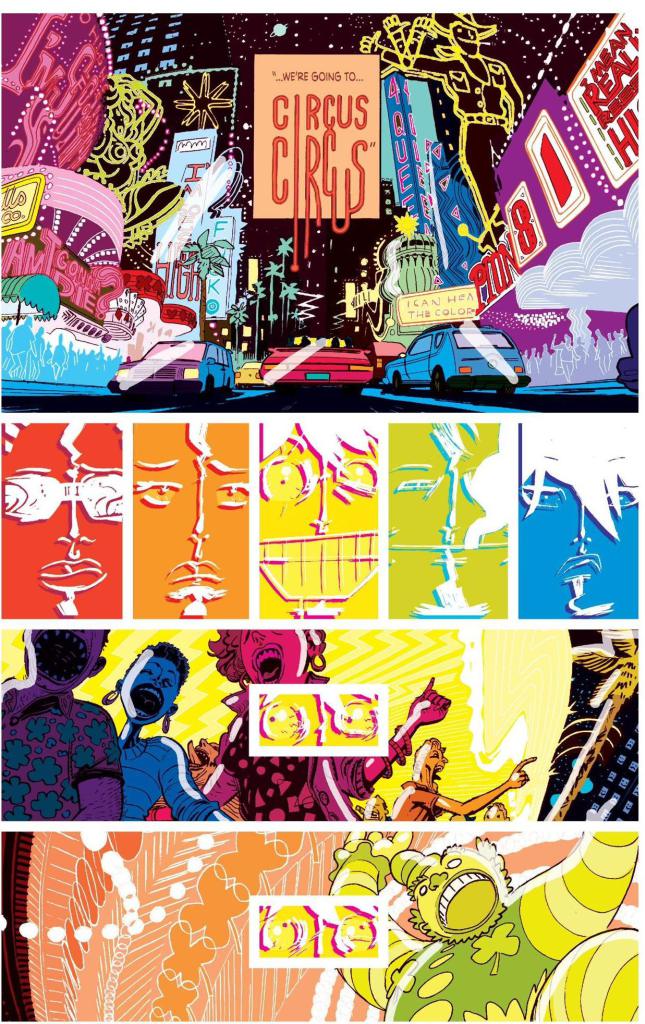
CB: In that same vein, does the conversational collaboration extend to working with Lee?
WC: Well, he’s amazing so I pretty much do let him do what he wants unless there’s something very specific that I have in mind. But when he’s finished with the colors, I might go in and tweak something; it’s very alive as we’re working on it. When Rick gives me the script, the dialogue is just the basic idea of what people say and when he gets the artwork, he goes in and write the actual dialogue. It’s always ongoing and forming as we’re working on it. When I’m working on the art, I have ideas for the colors, but since I like to be left alone and come up with my own ideas, I try to do the same thing for Lee. We set the tone for the colors in the beginning; looking at a Batman: Year One and 80’s colors – it was a good inspiration. I’m [also] a big fan of John Workman as a letterer, so when we’re talking to Rus Wooton, I was asking if he could do the thing with circular balloons with a clipped-off tail that’s kind of John Workman’s way of doing it–Alex Toth did balloons the same way. I thought that would be cool, but aside from that, once we set the tone its hands off and we let them do what they do.
CB: Something I love with Lee’s work on Deadly Class is that he has this amazing perceptive use of black tones.
WC: Yeah, like any good colorist, he understands how to tell a story with the color. He doesn’t like to color until it’s all the artwork is in which can get a little bit tight on the deadline, but just like how I don’t let getting script pages one at a time, he wants to be able to see the whole thing at once.
CB: For Rick, this is a very personal story where he’s bringing in a lot of his own youth. Does any of that happen to you?
WC: Yeah, visual-wise. I get to slip in the occasional thing that’s for me. None of it is obvious, just background things you may not pick up on. I’m a little bit younger than Rick; his teens years were late 80’s and mine were early 90’s, so I’m a bit more of a grunge Nirvana kind of a kid and he’s a punk guy. In that era, my experiences are a little more flowery and nice because I was just a kid with Saturday morning cartoons, but he was a teenager going through the kind of crazy stuff you go through. I just take what I went through as a teenager and relate it back to the 80’s version – it’s all the same thing. He was a punk growing up and I was more of a rockabilly kid, but that sort of comes from a punk thing so we both had very similar stuff happen to us there. His stories are way crazier, but we’ve both been jumped, both been in fights, both done…stuff. Drugs and whatever else.
CB: I think it’s important for people working together to be coming from a unique perspective – from a personal place.
WC: It takes a while to do that, but that’s how it works best. I’m not one of those people who would have a public facebook account for everyone to look at; I don’t put my personal life out there. But to have it matter, you definitely have to put a bit of yourself into the work or else it’s just kind of dry and unrealistic.
CB: Shifting gears a bit – one of the things that really draws people to Deadly Class is the covers. How does a cover form for you and how do you start making it?
WC: Well, Rick likes them to be traditional in style, where the covers have to do with something that’s going on in that issue. The covers need to be done way in advance of the actual pages, so I don’t find that works very well for me. We just need to have them thematically match up with season or that story arc or whatever it is, which is kind of the way it’s going right now. The covers I’m doing right now aren’t exactly about what’s going on in that issue, but they have to do with that time in the school. I come up with a lot of thumbnails–a lot of roughs–trying to think of something visually standout and interesting. I shoot them over to our editor Sebastian Griner and Rick and we talk about what’s hitting us – I obviously push the ones I like the most. The thing with this stuff is there’s no Superman or Batman or Spider-Man on the cover to sell the comic to people. I think a lot of the Image stuff is really interesting cover-wise because you have to do something to stand out from the bunch. Unless you’re Walking Dead or Saga, you have to do something to stand out, so a lot of people have very design-y covers so they don’t get lost in the pack of comics.
CB: It totally works, at least for me. When Deadly Class comes out, I put it on the top of my stack to say “look at this sweet-lookin’ book.”
WC: [Laughs] Yeah, that’s the idea. This is kind of a blood-dripping kind of theme [gesturing to his banner] but it could be paint, it could be blood; it’s just a dripping motif I try to incorporate into some of the covers and stories. I visualize that if it ever became a TV show, the would have to use it in the opening credits in some way.
CB: Along those lines, I’m curious about your use of recurring symbology in both Blackhand and Deadly Class. How conscious are you when creating these and making sure they serve their purpose.
WC: I’m pretty conscious of it. I don’t have as much control over it in Deadly Class since it’s Rick’s story, but if I can find a way to fit in a previously used symbol I will. For instance, when Marcus’s parents are killed, he lets go of a balloon and if you use that enough, it’ll mean something to the reader. You don’t have to show the whole flashback again, you can show just a little glimpse of the balloon and that means Marcus is thinking back about his parents. I saw it in David Mack’s Kabuki a lot; he would reuse these same symbols over and over again. Frank Miller did it a lot too; like the death scene in Dark Knight Returns, where his mom’s pearl necklace is snapped – you see it in slow motion and it becomes little circles. Then, three or four chapters later, all you have to show is that one little panel with those circles, and you know what he’s thinking.
It’s a strong thing that comics get to use, you can make a richer experience for the reader if you layer it that way. In Blackhand, I have full control of that so I try to have recurring elements a lot. It works better in a longer form like Deadly Class or a graphic novel where you have the pages to repeat, repeat, repeat until it means something to the reader. It’s like hitting notes [taps fingers on table], it becomes like a note in a song.
CB: Like hearing two seconds of a song and knowing exactly what it is?
WC: Yeah, there’s certain things we [comics] don’t have. We don’t have music, we don’t have motion. Music is a major thing that’s able to influence or manipulate people’s emotions; we can’t have that, but we can have other things like symbols. Not to hearken back to these 80’s comics, but Watchmen has these recurring elements that are really effective at hitting you. All of them become something more, and they get to play on it with variations, like there’s the bit with Dr. Manhattan with the smiley-face on Mars.
CB: It can add new perspectives to already an already touched-on theme.
WC: Especially with Deadly Class where the story is crazy and all-over-the-place, the use of recurring symbols can give it a form of cohesion.
CB: It’s successful visual storytelling.
WC: [Laughs] Thanks man.
CB: No Wes, thank you.
Wes Craig is an illustrator currently in Montreal and the artist on Deadly Class. You can also see his Blackhand Comics webcomic here.
The first volume of Deadly Class, “1987 – Reagan Youth” and the first volume of Blackhand Comics are available in print from Image Comics.



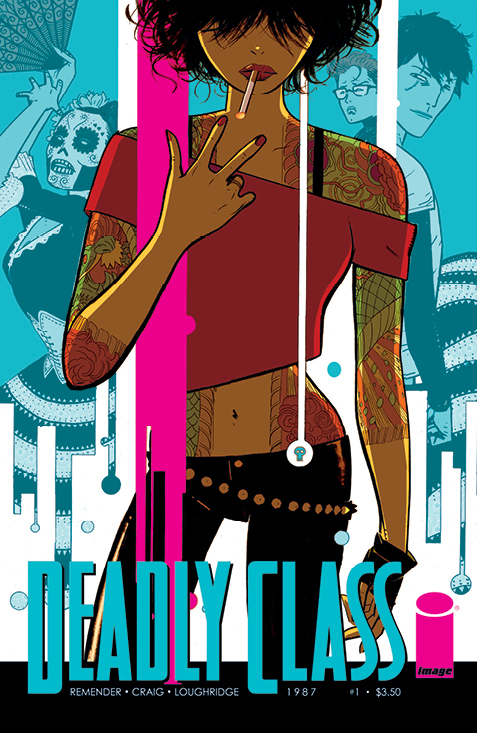



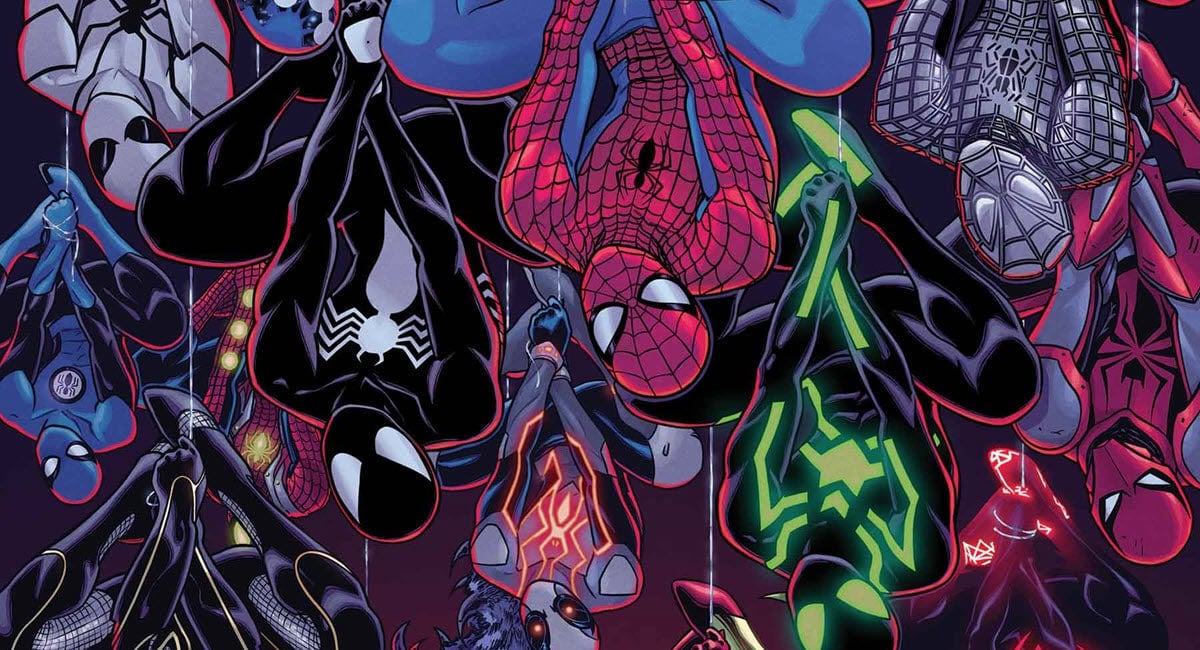

Comments are closed.